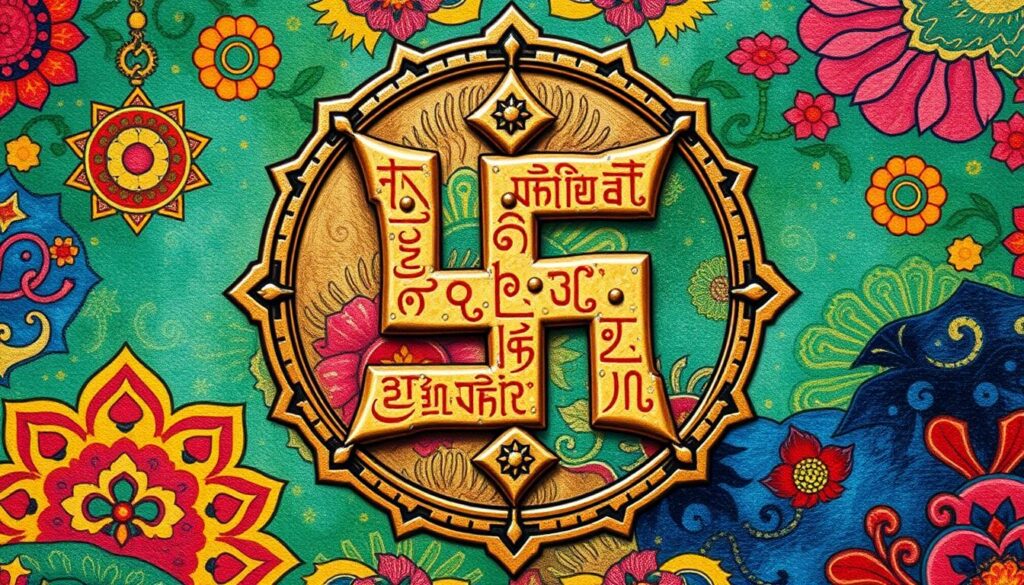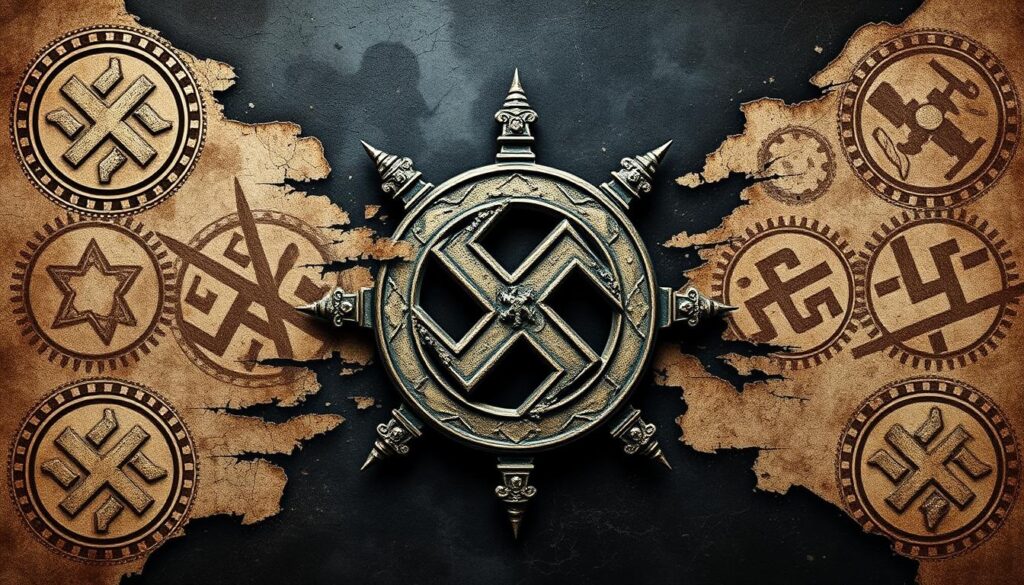The swastika was once a symbol of good fortune in many cultures. It has taken a dramatic and disturbing turn in history. The oldest swastika was found on an ivory figurine in Ukraine, over 15,000 years old.
For centuries, it was seen as a positive symbol. It was used in architecture, ads, and even military symbols in the West.
In the 20th century, the Nazi regime changed the swastika’s meaning. They made it a symbol of hatred and extremism. This symbolism shift has had a lasting impact. Now, there are efforts to ban the swastika, despite its rich history.
Introduction to Symbolism Shift
Symbolism shift is when symbols change in meaning and how we see them. The swastika is a great example. It was once a symbol of good luck and prosperity in ancient cultures. But now, it’s seen as a symbol of hatred.
What is Symbolism Shift?
Symbolism shift happens when a symbol’s meaning changes a lot. This can be because of history, culture, or politics. The same symbol can mean very different things to different people, based on where they are and what they believe.
Historical Context of Symbols
To understand symbolism shift, we need to look at the past. The swastika’s change from a sacred symbol to a symbol of oppression shows how meanings can change. Looking at how symbols have been seen and used over time helps us understand their shifts.
“The meaning of a symbol is not inherent in the symbol itself, but is shaped by the cultural and historical context in which it is used.”
![]()
![]()
By studying the history of symbols, we learn how they’ve been seen and used. This helps us deal with the changing meanings of symbols today. It’s important for understanding the complex world of symbols.
The Origins of the Swastika
The swastika’s history goes back to ancient times across the globe. This symbol, known for its unique shape, has a long and complex past. It has been shaped by Semiotic Adaptation and Symbolic Reinterpretation over the years.
Ancient Uses in Various Cultures
The swastika first appeared in Eurasia about 7,000 years ago. It was part of the Neolithic Vinca culture in southeastern Europe. By the Bronze Age, it spread to many ancient societies, like Ancient Greece, the Celts, and the Anglo-Saxons.
Symbol of Prosperity and Good Fortune
In old times, the swastika was seen as a sign of wealth, luck, and health. In Asia, it was linked to Buddha’s steps and was seen as lucky in Hinduism, Buddhism, and Jainism. Its positive meaning and use in many cultures show its importance in Semiotic Adaptation and Symbolic Reinterpretation.


“The swastika is one of the oldest and most widespread symbols in human history, appearing in the archaeological record of various ancient cultures around the world.”
The Swastika in Eastern Spirituality
In Eastern spirituality, the swastika is very important. It has been loved for centuries in Hinduism, Jainism, and Buddhism. It stands for good fortune, prosperity, and well-being.
This symbol is still used in many religious and cultural events in the Indian subcontinent.
Hinduism and Jainism Perspectives
In Hinduism, the swastika is seen as a lucky symbol. You can find it in temples, religious books, and at festivals. It shows the four main states of existence in Jainism: Reincarnation, Moksha, Samsara, and Nirvana.
The swastika’s ability to change meaning is key. It shows how these deep spiritual ideas can be connected.
The Swastika’s Spiritual Significance
- The word “swastika” comes from the Sanskrit roots “su” (good) and “asti” (to prevail), meaning “wellbeing” or “good fortune.”
- In Buddhism, the swastika is known as the “manji” and symbolizes the Buddha’s footprints, representing the propagation of his teachings.
- The swastika remains a prevalent symbol in India, appearing on shop doors, vehicles, and even food packaging, signifying its deep-rooted cultural and spiritual significance.
The swastika’s meaning in Eastern spirituality is very different from its meaning in the West. This shows how important it is to understand a symbol’s history and cultural context.


Early Western Adoption of the Swastika
The symbolic meaning and cultural semiotics of the swastika have changed a lot over time. In the early 1900s, Western cultures saw the swastika as a sign of good luck and wealth. This ancient symbol, over 11,000 years old, was used in buildings, brands, and pop culture in Europe and North America.
The Danish brewery Carlsberg Group used the swastika on their logo from the 1800s until the 1930s. The Finnish Defence Forces also used it from 1918 to 1945. In Ireland, the Swastika Laundry company had it on their vans and chimneys until recently.
Art Nouveau and Architectural Uses
The swastika was very popular in the West, especially in Art Nouveau. It was seen as a symbol of luck and spiritual health. Architects and designers put the swastika in buildings and products, like furniture and textiles.
The Swastika in Popular Culture
The swastika was also big in pop culture. The Boy Scouts of America had it on their badges until 1940. The Royal Air Force (RAF) in the UK had it on their planes until 1939. Even Coca-Cola tried it on their products in the early 1900s.
But everything changed with Nazi Germany in the 1930s. The swastika became linked to the Holocaust and World War II horrors. Its cultural semiotics changed, turning it into a symbol of hate and oppression.


The Turning Point: World War II
The swastika’s meaning changed a lot during World War II. The Nazi Party started using it in 1920. This made it linked to fascism, totalitarianism, and genocide.
Nazi Germany and the Shift in Meaning
Adolf Hitler chose the swastika for its supposed link to Aryan ancestry. This choice made it a symbol of racial purity and German nationalism. The Nazi regime turned it into a symbol of war atrocities, changing how people saw it in the West.
How Propaganda Changed Public Perception
The Nazis used the swastika a lot in their propaganda. They changed its meaning to one of hate and oppression. This was done through powerful images and messages.
“The Nazi Party’s adoption of the swastika in 1920 marked a turning point in its symbolism, as it became increasingly associated with fascism, totalitarianism, and genocide during World War II.”
World War II had many turning points, each seen differently by historians. Events like the German victory in France in 1940 and the Battle of Stalingrad were key. These moments changed the war’s direction.
![]()
![]()
The swastika’s meaning changed a lot during World War II. Its link to Nazi atrocities has made it a symbol of controversy today. Its impact is clear and lasting.
Contemporary Views on the Swastika
In today’s world, the swastika is a symbol of much debate. It’s still valued in Eastern cultures but seen as a sign of hate in the West. The way we see this ancient symbol has changed a lot.
The Swastika in Modern Society
The swastika’s link to Nazi atrocities has overshadowed its true meaning. It was once a symbol of good luck and prosperity in Hinduism and Buddhism. But in the West, it’s mainly remembered for the Holocaust.
Attempts to Reclaim the Symbol
Lately, some have tried to bring back the swastika’s positive meanings. In Copenhagen, Denmark, tattoo artists are working to restore its original significance. But, changing its image is hard because of its Nazi connection.
Changing how we see the swastika is a complex issue. Different cultures have different views, leading to ongoing debates about its use today.


“The swastika is a symbol that has been used for thousands of years, with positive meanings in many cultures. Yet, its association with the Nazi regime has made it one of the most controversial symbols in the world.”
The Psychological Impact of Symbolism
Symbols have a strong effect on how we see and feel things. The swastika’s change shows how events can change a symbol’s meaning. For those who lived through the Holocaust, the swastika brings up fear, trauma, and sadness. This is true, even though it was once a symbol of Signifier Realignment and Emblematic Fluidity.
These symbols leave a mark on our culture and feelings. When a symbol is linked to bad events, it can make us feel strongly, even years later. This shows how symbols deeply affect our shared and personal experiences.
How Symbols Influence Perception
Symbols are more than just pictures; they open up to deeper meanings. Our understanding of symbols comes from our personal and cultural backgrounds. A symbol that once meant good luck can now symbolize hate and fear, deeply affecting our feelings and thoughts.
The Impact of History on Symbolism
- The swastika’s change from a symbol of good fortune to a Nazi symbol of hate shows the power of history in changing a symbol’s meaning.
- Symbols change and gain new meanings as they are used and reinterpreted over time.
- The history of a symbol can have a lasting effect on how it is seen and felt by people and groups.
“Symbols are the language of the soul, and their impact on our psyche cannot be overstated. The swastika’s journey from a sign of good fortune to a symbol of unspeakable atrocities is a poignant reminder of the power of symbolism to shape our collective consciousness.”
It’s important to understand how symbols affect us. This helps us deal with the complex and emotional world of cultural and historical symbols. By recognizing the deep impact of symbols, we can work towards more empathy, sensitivity, and thoughtful discussions about these powerful symbols.
Cultural Reappropriation and Misunderstanding
The swastika’s journey is complex, with efforts to reclaim its original meaning facing big challenges. It predates the Nazi use by about seven millennia and holds deep spiritual value in Eastern cultures. Yet, its link to hate and oppression in the West has caused a big divide.
Reclaiming the Swastika in Various Cultures
In Asian countries, the swastika still means prosperity and good luck, as it has for centuries in Hinduism and Jainism. But in the West, it’s often seen as a Nazi symbol. This has led to misunderstandings, like the removal of Hindu Diwali decorations in New York.
Misunderstanding and Stereotypes in the West
How we see symbols is very personal, and the swastika’s meaning changes across cultures and people. Our brains look for patterns, and symbols are linked to human smarts. Yet, the question remains if the swastika can ever be seen apart from its Nazi ties in the West.
“Symbols and symbolic systems are intrinsically tied to human intelligence, and the way we interpret them is highly personal.”
Understanding cultural symbols is key, but it’s also about education, awareness, and sensitivity. As we delve into the meanings of symbols, we must consider their history and impact on communities.
Legal and Social Responses to Symbolism Shift
As symbols like the swastika have changed, governments and communities face big challenges. Many countries have laws against using Nazi symbols. This shows a tough balance between free speech and stopping hate speech.
Hate Speech Laws and Their Implications
Germany leads in fighting the swastika and other Nazi symbols. They even tried to ban them across the EU in 2007. These laws aim to deal with the Third Reich’s legacy and prevent harm. But, they also raise questions about free speech limits and defining hate speech.
Community Reactions to Modern Symbolism
People have different views on using the swastika and other symbols. It leads to deep talks about history, culture, and freedom in art and learning. Some want to keep these symbols in the past. Others believe in reusing them, stressing the need for education and understanding.
“The swastika’s journey from an ancient symbol of good luck to an icon of hate is a sobering reminder of the power and fragility of symbolism in human societies.”
As we deal with these symbols, our laws and social views keep changing. This shows we need careful, thoughtful, and inclusive ways to handle our cultural past and future.
The Role of Education in Addressing Symbolism Shift
Understanding the swastika’s history and modern meanings is complex. Educators play a key role in teaching this. They help by giving historical context and promoting understanding.
Importance of Historical Context in Education
Teaching the swastika’s cultural origins is crucial. It goes beyond the Nazi’s misuse. Students should learn it symbolized prosperity and good fortune in Eastern religions.
This knowledge helps bridge cultural gaps. It leads to deeper discussions about symbolism’s evolution.
Initiatives to Foster Understanding
Many educational programs tackle the swastika’s complex history. They aim to show its varied meanings and challenge wrong beliefs. These efforts help explain the symbol’s nuances.
They aim to increase understanding and sensitivity. This is for students and the wider community.
“Education is the most powerful weapon which you can use to change the world.” – Nelson Mandela
Education is key in understanding the swastika’s history and cultural importance. It helps us appreciate its complex past and significance today.
Conclusion: Navigating Symbolism in the Modern World
The swastika’s journey shows how symbols change over time. It went from a symbol of good luck to a sign of hate. This change is hard to reverse because of its link to Nazi Germany.
This debate shows we need to be careful with symbols. We must understand their history and talk openly about them. This helps us live in a world where everyone’s views are respected.
A Call for Awareness and Sensitivity
When we talk about symbols, we must know their background. We should be ready to have deep conversations. Symbols can hurt or unite us, like the swastika did.
Being aware and sensitive helps us use symbols wisely. This way, we can make our world more welcoming and understanding for everyone.
The Future of Symbolism and Its Interpretations
As the world changes, so will symbols. Artists like Basquiat and Mullashev are already showing us new ways to see symbols. They draw from many cultures and stories.
The future of symbols will be filled with new meanings and uses. This will show how history, culture, and personal stories mix together. By embracing this mix, we can better understand symbols and how they shape our lives.
Source Links
- https://www.bbc.com/news/magazine-29644591
- https://www.businessinsider.com/how-the-swastika-went-from-symbol-luck-emblem-of-evil-2023-3
- https://stars.library.ucf.edu/cgi/viewcontent.cgi?referer=&httpsredir=1&article=1953&context=honorstheses1990-2015
- https://www.thesymbolicworld.com/content/introduction-to-symbolism
- http://www.scholarpedia.org/article/Symbolic_dynamics
- https://encyclopedia.ushmm.org/content/en/article/history-of-the-swastika
- https://www.smithsonianmag.com/history/how-the-swastika-an-ancient-symbol-of-good-fortune-used-around-the-world-became-the-nazi-logo-180962812/
- https://pwestpathfinder.com/2021/04/22/the-history-of-the-swastika-how-a-symbol-of-peace-was-corrupted-into-a-symbol-of-hate/
- https://www.bbc.com/culture/article/20210816-the-ancient-symbol-that-was-hijacked-by-evil
- https://www.printmag.com/daily-heller/the-daily-heller-when-is-a-swastika-not-a-hate-symbol/
- https://en.wikipedia.org/wiki/Western_use_of_the_swastika_in_the_early_20th_century
- https://www.historyextra.com/period/second-world-war/how-why-sanskrit-symbol-become-nazi-swastika-svastika/
- https://www.historynet.com/turning-point-world-war-ii/
- https://origins.osu.edu/milestones/august-2017-stalingrad-75-turning-point-world-war-ii-europe
- https://www.history.com/topics/world-war-ii/world-war-ii-history
- https://www.npr.org/sections/codeswitch/2016/10/28/499475248/diwali-dilemma-my-complicated-relationship-with-the-swastika
- https://en.wikipedia.org/wiki/Swastika
- https://www.cgjungny.org/symbolism-in-the-arts-a-psychological-phenomenon-for-clinical-and-personal-applicationsreading-jung-on-psychology_and_religion/
- https://iaap.org/jung-analytical-psychology/short-articles-on-analytical-psychology/symbol-2/
- https://medium.com/@aaronweinstein/the-problem-with-symbolic-appropriation-cac179a04d69
- https://www.ictinc.ca/blog/why-cultural-appropriation-is-disrespectful
- https://www.muddycolors.com/2019/02/cultural-appropriation-vs-appreciation/
- https://www.simplypsychology.org/symbolic-interaction-theory.html
- https://courses.lumenlearning.com/wm-introductiontosociology/chapter/symbolic-interactionism-and-deviance/
- https://en.wikipedia.org/wiki/Symbolic_interactionism
- https://pmc.ncbi.nlm.nih.gov/articles/PMC2914350/
- https://michaelfullan.ca/books/new-meaning-educational-change/
- https://academic.oup.com/jdsde/article/13/2/225/370631
- https://art-mine.com/collectors-corner/2023/09/symbolism-in-contemporary-art-a-continuum-of-coded-language/
- https://www.structural-learning.com/post/symbolic-interaction-theory
